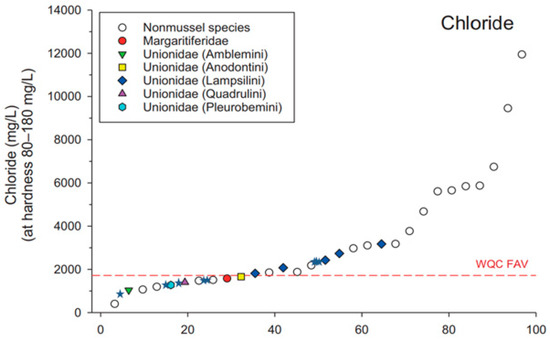Error in Figure
Figures 5 and 6 (and their corresponding legends) were inadvertently omitted from the final publication of the original paper [1]. The corrected Figure 5 and Figure 6 appear below. The authors state that the scientific conclusions are unaffected. This correction was approved by the Academic Editor. The original publication has also been updated.

Figure 5.
Ranked species sensitivity to chloride (adapted from Wang et al., 2017 [16]). The dotted red line represents the final acute value (FAV) in the US EPA ambient water quality criteria (WQC). The colored symbols represent juvenile freshwater mussel toxicity tests, while the open circles represent fish and invertebrate toxicity tests. Chloride 24-h EC50s for glochidia from freshwater mussels (Lampsilis fasciola, L. siliquoidea, A. suborbiculata, and Hamiota altilis) are indicated by blue stars (☆).

Figure 6.
Ranked species sensitivity to potassium (adapted from Wang et al., 2017 [16]). The colored symbols represent juvenile freshwater mussel toxicity tests, while the open circles represent fish and invertebrate toxicity tests. Potassium EC50s for glochidia (Lampsilis fasciola, L. siliquoidea, and Hamiota altilis) are indicated by blue stars (☆).
Reference
- Bringolf, R.B.; Raines, B.K.; Ratajczak, R.E.; Haskins, D.L. Major Ion Toxicity to Glochidia of Common and Imperiled Freshwater Mussel Species. Diversity 2022, 14, 95. [Google Scholar] [CrossRef]
Disclaimer/Publisher’s Note: The statements, opinions and data contained in all publications are solely those of the individual author(s) and contributor(s) and not of MDPI and/or the editor(s). MDPI and/or the editor(s) disclaim responsibility for any injury to people or property resulting from any ideas, methods, instructions or products referred to in the content. |
© 2023 by the authors. Licensee MDPI, Basel, Switzerland. This article is an open access article distributed under the terms and conditions of the Creative Commons Attribution (CC BY) license (https://creativecommons.org/licenses/by/4.0/).